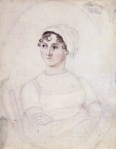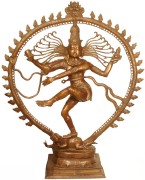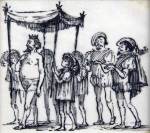
We’re heading into Transylvania today. The skies should be leaden, with lightning strobing in the wet gloom and thunder grumbling like a distant artillery barrage. Instead we’re travelling in bright sunshine and a soft summer breeze. No Hollywood cliches here.
We know today is going to be a slow day — the four lane highway finished just outside Szeged, and according to the map, the next time we’ll see one is somewhere near Bucharest — but we are a little surprised when the Garmin directs us down a string of back roads to an ancient car ferry over the Tisza River. We are even more surprised to have to wait 20 minutes to board the thing, even though it is pulled up on our side of the river. Seems the ferry departs every half hour — even though the river is only a couple of hundred yards wide and takes about 10 minutes to cross.

The road the other side is a challenge. It is tarmac, but its foundations are so poor it has collapsed into a series of humps and hollows that would challenge the suspension on a Baja racer. We have both Hyundais darting and weaving all over the road as we try to keep the wheels on the high ground, and the oil pans away from the hungry road surface. We struggle to average much more than 40 mph on the run to join Route 68, the road that will take us east into Romania, and Transylvania — its most famous region.

Romania is probably best known to most Americans for its Olympic gymnasts, while Transylvania has become a pop culture icon through countless retellings of Irish writer Bram Stoker’s classic 1897 novel, Dracula, in which the Count himself travels on the Orient Express. The real Romania is somewhat more complicated than that.

It’s been almost 20 years since the Romanians deposed Nicolae Ceausescu, but the brutal Communist dictator’s legacy is still all too visible. Romania today has ATMs and gas stations and shiny new car dealerships. But it also has tumbledown villages with dirt streets, hordes of battered old Dacia 1300s (basically badly-built 1970s Renault 12s), and a landscape dotted with ugly, rusting Soviet-era infrastructure.

Just outside the town of Arad, a beggar pushes a wheelchair into the middle of moving traffic at a rail crossing near a decaying power station, pulling up the pant legs of the poor unfortunate in the chair to show his amputated limbs. Rich and prosperous Europe suddenly seems a million miles away…

Leaving out the time spent on photography, crossing the border, gassing cars, and lunch, it has taken us about eight hours to cover less than 250 miles today. The E68, one of the main roads into the country from the west, is virtually a two lane highway all the way. If you’re not stuck behind a semi, you’re cruising at 30 mph through one of the countless towns and villages along the way, and you have to crawl over every rail crossing or leave your front suspension behind. You might think it’s best to simply chill, and go with the flow. But the Romanians have other ideas.


With traffic banked up behind a truck, impatient drivers simply pull out and pass long lines of cars, relying on someone letting them back onto the right side of the road before they eat an oncoming semi. It mostly seems to work, though we saw a couple of close shaves, most notably a guy in a white BMW who decided to ignore the double lines and pass on a blind crest just as a truck appeared coming the other way. When it doesn’t work, it gets messy. We saw three wrecks — one car upside down by the side of the road, another teetering crazily down an embankment, and a third facing the wrong way with its front end pushed in.

We quickly learned to take a leaf out of the locals’ book — well, a little part of it, anyway. Being the nice guys meant we kept getting shuffled back in the line behind the trucks, so when we were certain the road ahead was clear, we made good use of the Tau V-8′s 375 hp, overtaking small groups of cars en masse so we could position ourselves to pass the lumbering semi at the head of the line. I felt sorry for those Romanians driving the Communist-era Dacias which simply don’t have the power to pass a modern truck; they had no alternative but to sit there sniffing diesel fumes. Forever.

We’re overnighting in Sibiu, one of the major towns in Transylvania. Tomorrow, we’re taking the long way to Bucharest, via the Transfagarasan Road, a Ceausescu folly through the brooding Fagaras Mountains that may just be one of the best driver’s roads in Europe. And along the way we plan to check out at the one-time hangout of the real Dracula. Yes, he existed, and yes, he was a bloodthirsty character. But not in the way you’re thinking.
-Photos by Brian Vance
ORIENT EXPRESS SERIES: Day 1: Paris to Strasbourg — Day 2: Strasbourg to Munich — Day 3: Munich to Vienna –; Day 4: Vienna to Szeged, Hungary


We know today is going to be a slow day — the four lane highway finished just outside Szeged, and according to the map, the next time we’ll see one is somewhere near Bucharest — but we are a little surprised when the Garmin directs us down a string of back roads to an ancient car ferry over the Tisza River. We are even more surprised to have to wait 20 minutes to board the thing, even though it is pulled up on our side of the river. Seems the ferry departs every half hour — even though the river is only a couple of hundred yards wide and takes about 10 minutes to cross.

The road the other side is a challenge. It is tarmac, but its foundations are so poor it has collapsed into a series of humps and hollows that would challenge the suspension on a Baja racer. We have both Hyundais darting and weaving all over the road as we try to keep the wheels on the high ground, and the oil pans away from the hungry road surface. We struggle to average much more than 40 mph on the run to join Route 68, the road that will take us east into Romania, and Transylvania — its most famous region.

Romania is probably best known to most Americans for its Olympic gymnasts, while Transylvania has become a pop culture icon through countless retellings of Irish writer Bram Stoker’s classic 1897 novel, Dracula, in which the Count himself travels on the Orient Express. The real Romania is somewhat more complicated than that.

It’s been almost 20 years since the Romanians deposed Nicolae Ceausescu, but the brutal Communist dictator’s legacy is still all too visible. Romania today has ATMs and gas stations and shiny new car dealerships. But it also has tumbledown villages with dirt streets, hordes of battered old Dacia 1300s (basically badly-built 1970s Renault 12s), and a landscape dotted with ugly, rusting Soviet-era infrastructure.

Just outside the town of Arad, a beggar pushes a wheelchair into the middle of moving traffic at a rail crossing near a decaying power station, pulling up the pant legs of the poor unfortunate in the chair to show his amputated limbs. Rich and prosperous Europe suddenly seems a million miles away…

Leaving out the time spent on photography, crossing the border, gassing cars, and lunch, it has taken us about eight hours to cover less than 250 miles today. The E68, one of the main roads into the country from the west, is virtually a two lane highway all the way. If you’re not stuck behind a semi, you’re cruising at 30 mph through one of the countless towns and villages along the way, and you have to crawl over every rail crossing or leave your front suspension behind. You might think it’s best to simply chill, and go with the flow. But the Romanians have other ideas.


With traffic banked up behind a truck, impatient drivers simply pull out and pass long lines of cars, relying on someone letting them back onto the right side of the road before they eat an oncoming semi. It mostly seems to work, though we saw a couple of close shaves, most notably a guy in a white BMW who decided to ignore the double lines and pass on a blind crest just as a truck appeared coming the other way. When it doesn’t work, it gets messy. We saw three wrecks — one car upside down by the side of the road, another teetering crazily down an embankment, and a third facing the wrong way with its front end pushed in.

We quickly learned to take a leaf out of the locals’ book — well, a little part of it, anyway. Being the nice guys meant we kept getting shuffled back in the line behind the trucks, so when we were certain the road ahead was clear, we made good use of the Tau V-8′s 375 hp, overtaking small groups of cars en masse so we could position ourselves to pass the lumbering semi at the head of the line. I felt sorry for those Romanians driving the Communist-era Dacias which simply don’t have the power to pass a modern truck; they had no alternative but to sit there sniffing diesel fumes. Forever.

We’re overnighting in Sibiu, one of the major towns in Transylvania. Tomorrow, we’re taking the long way to Bucharest, via the Transfagarasan Road, a Ceausescu folly through the brooding Fagaras Mountains that may just be one of the best driver’s roads in Europe. And along the way we plan to check out at the one-time hangout of the real Dracula. Yes, he existed, and yes, he was a bloodthirsty character. But not in the way you’re thinking.
-Photos by Brian Vance
ORIENT EXPRESS SERIES: Day 1: Paris to Strasbourg — Day 2: Strasbourg to Munich — Day 3: Munich to Vienna –; Day 4: Vienna to Szeged, Hungary











































